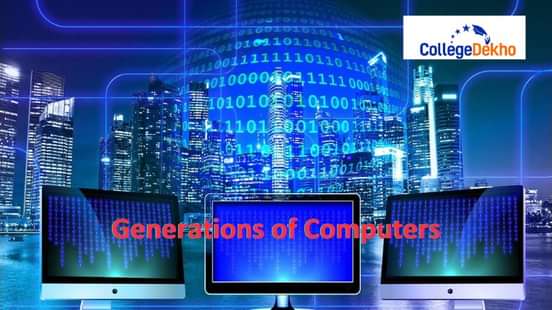
Generations of computers have evolved significantly over the decades, each with its own set of features that have made significant contributions to our daily work. From the large, room-sized mainframe computers of the 1940s to the sleek and powerful personal computers and laptops of today, the evolution of computers has been truly remarkable. These advancements have transformed how we communicate, work, and entertain ourselves.
Whether it’s typing emails, creating complex spreadsheets, editing videos, or watching your favourite movie, computers are capable of a plethora of functions. But do you know they were not as functional in their initial phases? Let’s explore the generations of computers and the way they developed over time to gain a deeper understanding of the technological advancements that have shaped the world we live in today.
Also Read:
| BCom Computers Vs BCom General | Career Scope after PCM with Computers in Class 12th |
|---|---|
| B.Sc Mathematics vs B.Com Computers | |
Generation of Computers: Timeline
The first use of computers can be traced back to the 16th century when it was associated with calculation and was called the “Abacus”. One of the fathers of computers, Charles Babbage developed the first mechanical computer in 1822. Then in 1833, he further revolutionized this mechanical computer by designing an Analytical Engine. This was the beginning of an era where different generations of computers possessing a set of characteristics significantly impacted different fonts of work and life.
Generations of Computer | Technology | Timeline |
|---|---|---|
1st Generation | Vacuum Tube | 1940-1956 |
2nd Generation | Transistor | 1956-1963 |
3rd Generation | Integrated Circuit | 1964-1971 |
4th Generation | Microprocessor | 1971-2010 |
5th Generation | Artificial Intelligence | 2010-Present |
Characteristics of Different Generations of Computers
To understand the challenges, updates, and evolutions that went into the computer system we now see, it is vital to explore the different generations of computers. As this technology came in the 16th century, it underwent five generations of evolution. Each of the generations has its set of characteristics which we have discussed below.
1st Generation of Computers: 1940-56
The first generation of computers was bulky and used for calculations and storage only. They relied on vacuum tubea, a type of glass device. These computers were built using a low level of programming language, which made working with them quite challenging. In fact, the use of high-end electricity posed challenges in their maintenance. Some of the examples of 1st generation computers include ENIAC, EDVAC, and UNIVAC.
Here are some of their characteristics:
- The 1st generation computers were characterized by their heavy weight and slow working.
- Machine languages were used to run the programs.
- Magnetic drums and magnetic tapes formed the core memory of this computer.
- To enhance the functioning of external storage, punch cards were used.
2nd Generation of Computer: 1956-63
In the second generation of computers, the bulky vacuum tubes were replaced by transistors which offered better functionality as their size was reduced from the first generation. Transistors were founded by Bell Labs which contributed towards developing this generation of computers.
Explore the top features and characteristics of 2nd generation computers
- The Second generation of computer technology relied on two types of programming languages- Machine and Assembly language.
- Unlike, the 1st gen of computer technology, this new type of computer consumed comparatively low power due to a smaller size.
- Its input and output devices were formed of magnetic tape and punched cards.
- Some of the examples of this generation of computers include CDC 3600, IBM 7090, PDP-8, UNIVAC 1107, etc.
3rd Generation of Computers: 1964-1971
The third generation of computers became more functional with advanced features that made work easier. With the advent of a new era, a subsequent shift to Integrated circuits was made. This generation of systems switched from transistors to IC which enhanced its functionality. ICs generally consist of a variety of registers, capacitors, and transistors that are built on silicon.
Discover the characteristics of 3rd generation computers
- This is the phase when the keyboard, mouse, monitor, and printer were used as input and output devices.
- The use of IC enhanced the efficiency and memory space for the computer devices.
- For memory storage, larger magnetic tape, disk, or core were used.
- Higher levels of computing languages like BASIC (Beginners All-purpose Symbolic Instruction Code) were introduced followed by the introduction of mini-computers
- Some of the third-generation computers include IBM 370, PDP-11, UNIVAC 1108, IBM 360, etc.
4th Generation of Computers: 1972-2010
The era between 1970 and to 2000s marked the beginning of another new evolution in computer technology. A revolutionary technology that led to the development of computers is the microprocessor. A microprocessor helps in assembling different types of circuits that help in calculation, controlling functions, and logic.
Check out the top features of third-generation computers below:
- Random Access Memory (RAM) and Read Only Memory (ROM) acted as the semiconductor memory for this generation of computers.
- This generation registered the rampant usage of private computers like laptops.
- VLSI has been a driving technology behind the design of these computers
- Examples of 4th generation Alter 8800, IBM PC, STAR 1000, Apple Macintosh, etc.
5th Generation of Computers: 2010 till Future
We are witnessing the fifth generation of computer technology today whereby AI has taken a significant place. This generation of computers has been designed with a plethora of features that have enhanced their speed and functioning. Some of the significant AI revolutions include voice recognition, chatbots, E-payments, etc. One of the major principles used to design these computers is offering them human qualities.
Here are some of the top characteristics of fifth-generation computers
- The fifth-generation computers are made to understand human language.
- These are of portable size possessing a high memory with maximum storage space.
- A hub of new additions was made to the input and output systems. Some of the latest input/output include a trackpad, touchscreen, speech input, scanner, etc.
- Some of the examples of fifth-generation computers are desktops, laptops, tablets, etc.
We hope this article gave you an insight into the generation of computers and how they evolved. Each evolutionary period brought a plethora of technical advancements and also some challenges. Computers are still evolving and we believe in the future new technical advancements can bring significant changes in our lives!
Quick Links:
| List of Computer Courses After 12th | Best Data Science Courses Admissions 2024 |
|---|---|
| List of Artificial Intelligence (AI) and Data Science Courses after 12th | IT Courses List |

















Similar Articles
MP B Tech Admission 2024: Colleges, Dates, Eligibility
SRMJEEE 2024 Remote Proctored Online Mode (RPOM) Examination- Exam Day Instructions, Guidelines, Dates, Requirements, Process
B.Tech CSE Colleges Expected for 3,000 Rank in JEE Main 2024
Documents Required to Fill NATA 2024 Application Form - Photo Upload, Specifications, Scanned Images
Guidelines to Fill NATA 2024 Application Form
Is Physics and Chemistry Still a Part of the NATA Syllabus?